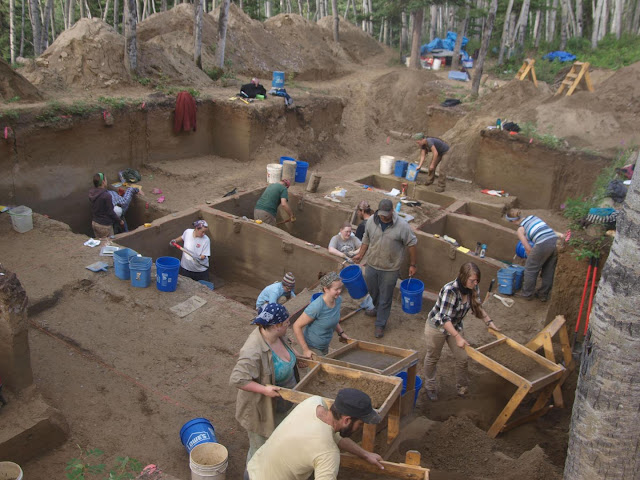Summary: Upward Sun River has oldest Alaskan, American, Beringian extracted DNA, an article in Oct. 26's Proceedings of the National Academy of Sciences finds.
 |
| Upward Sun River archaeological site; credit Ben Potter, University of Alaska Fairbanks: Usage restrictions -- Credit required, via EurekAlert! |
Nine co-authors answer questions on the route and timing of the earliest settlement of the Americas through research published online by the Proceedings of the National Academy of Sciences Oct. 26, 2015.
They base their conclusions upon artifacts, cremated bones of a 3-year-old and deoxyribonucleic acid extracted from the skeletons of a 6- to 12-week-old infant and a pre-term, stillborn 30-week fetus in an 11,500-year-old ceremonial grave near the Upward Sun River site not far from the confluence of central Alaska’s Little Delta and Tanana rivers.
The analysis centers upon mitochondrial DNA that is inherited maternally and reconstructed more easily than the cellular nuclear DNA which children inherit from both parents.
The discovery of the site dates back to 2010. The site evidences ceremonial aspects through a circular hearth upon which cremated bones are displayed and below which two intact skeletons are buried. Layers of the iron oxide-rich pigment associated with ancient burials and known as red ocher function as bedding. Hunting darts fashioned from deer antlers and spaced around the two sets of bones give ritual meaning to the below-ground, side-by-side burials.
Archaeologist Ben A. Potter, University of Alaska Fairbanks Department of Anthropology professor and Upward Sun River lead researcher, holds that “These things we hardly every find -- it’s a very rare window into the worldview of these people” regarding the site’s 13,200- to 8,000-year-old occupancy.
Genetic analysis at the University of Utah indicates that the children do not share the same mothers or maternal grandmothers and represent different genetic lineages. The nine co-authors judge the results as indicative of shared paternal lineages or settlement experiences with sudden infant deaths because of the emotional investment implicit in posed burials and the separate haplogroup memberships of the baby and the fetus.
Anthropologists know of both genetic lineages as present in modern Native Americans even though settlement models other than the Beringian standstill hypothesis confine B2 haplogroup members to southern tribes and C1b haplogroup members to northern tribes. That confinement links Anasazi and Navajo settlements to ancestral migrations separate from Siberian waves 25,000 years ago.
Standstills hypothesized in 2007 by Ripan S. Malhi, University of Illinois Department of Anthropology associate professor at Champaign-Urbana, make co-occurring lineages possible. They note glacier-free Beringia’s shrub tundra plains of birches, grazing animals, and spruces during the Last Glacial Maximum 30,000 to 15,000 years ago. Food and wood offer incentives for Native American ancestors mingling until the end of the world’s fifth major ice age 15,000 years ago.
Analysis of the first Beringian and oldest Alaskan and American genetic materials prompts Dennis H. O’Rourke, University of Utah Department of Anthropology professor and study co-author, to observe that “It may give us a snapshot of that earlier time” since Beringia’s submergence may preclude discovery of pre-glacial melt sites.
Acknowledgment
My special thanks to talented artists and photographers/concerned organizations who make their fine images available on the internet.
Image credits:
Image credits:
Upward Sun River archaeological site; credit Ben Potter, University of Alaska Fairbanks: Usage restrictions -- Credit required, via EurekAlert! @ https://www.eurekalert.org/multimedia/897327; (EurekAlert! news release URL @ https://www.eurekalert.org/news-releases/748592); (former URL @ https://www.eurekalert.org/multimedia/pub/101610.php?from=309444)
map of Alaska’s Upward Sun River infant burial sites and sites sharing same B2 and C1 lineages with infants; credit Ben Potter, University of Alaska Fairbanks: Usage restrictions -- Credit required, via EurekAlert! @ https://www.eurekalert.org/multimedia/897326; (EurekAlert! news release URL @ https://www.eurekalert.org/news-releases/748592); (former URL @ https://www.eurekalert.org/multimedia/pub/101611.php?from=309444)
For further information:
For further information:
IB Times UK. 11 November 2014. "Alaska Remains of Ice Age Infants Discovered in Burial Pit Beneath Cremated Toddler." YouTube.
Available @ http://www.youtube.com/watch?v=2VksoOzsiaE
Available @ http://www.youtube.com/watch?v=2VksoOzsiaE
Tackney, Justin C., et al. 10 November 2015. "Two contemporaneous mitogenomes from terminal Pleistocene burials in eastern Beringia." Proceedings of the National Academy of Sciences of the United States of America, vol. 112, no. 45 (Nov. 10, 2015): 13833-13838. DOI: 10.1073/pnas.1511903112
Available @ http://www.pnas.org/content/early/2015/10/21/1511903112
Available @ http://www.pnas.org/content/early/2015/10/21/1511903112
Zimmer, Carl. 26 October 2015. "DNA of Ancient Children Offers Clues on How People Settled the Americas." The New York Times > Science.
Available @ http://www.nytimes.com/2015/10/27/science/dna-of-ancient-children-offers-clues-on-how-people-settled-the-americas.html?ref=topics
Available @ http://www.nytimes.com/2015/10/27/science/dna-of-ancient-children-offers-clues-on-how-people-settled-the-americas.html?ref=topics

No comments:
Post a Comment
Note: Only a member of this blog may post a comment.